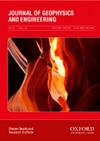Water alternative gas (WAG) optimization for a heterogeneous Brazilian pre-salt carbonate reservoir
IF 1.7
3区 地球科学
Q3 GEOCHEMISTRY & GEOPHYSICS
引用次数: 0
Abstract
Abstract Water alternating gas (WAG) is a cyclical process that involves alternating water and gas injections with the primary goal to improve sweep efficiency by maintaining initial high pressure, slowing water and gas breakthrough, and lowering oil viscosity. The objective of this work is to apply and optimize a WAG strategy on a carbonate field with light oil, compare it to the initially planned water-flooding strategy, and investigate the capability of WAG to improve field production. In this research, a compositional reservoir simulator was used to model a WAG process by injecting produced gas into the reservoir, using the same well structure as an optimized water-flooding strategy. Subsequently, a WAG strategy was created, optimizing the number and locations of wells, to facilitate a comparative analysis of the two recovery methods. The WAG optimization involved a detailed assessment of variables such as bottom hole pressure (BHP), WAG cycle duration, maximum gas oil ratio (GOR), and well positioning, to achieve a high net present value (NPV). The study focuses on the application of WAG optimization modeling in unconventional reservoirs, specifically pre-salt carbonate reservoirs, and investigates its implications on production strategy and forecast, emphasizing its potential for maximizing NPV and oil recovery in a recently producing field. The results showed that WAG improved reservoir performance when compared to water injection and produced a greater amount of oil. This solution showed potential to be tested under uncertainties (reservoir heterogeneity, faults, fractures, karsts, vugs, etc.) as future steps.巴西非均质盐下碳酸盐岩储层水替代气优化
水-气交替注入(WAG)是一个循环过程,涉及水-气交替注入,主要目标是通过保持初始高压、减缓水-气突破和降低油粘度来提高波及效率。这项工作的目的是在含轻质油的碳酸盐岩油田应用和优化WAG策略,将其与最初计划的水驱策略进行比较,并研究WAG提高油田产量的能力。在这项研究中,使用了一个组合油藏模拟器来模拟WAG过程,通过将产出的气体注入到储层中,使用相同的井结构作为优化的水驱策略。随后,制定了WAG策略,优化了井的数量和位置,以便对两种采收率方法进行比较分析。WAG优化包括对井底压力(BHP)、WAG循环时间、最大油气比(GOR)和井位等变量的详细评估,以实现高净现值(NPV)。研究重点是WAG优化建模在非常规油藏(特别是盐下碳酸盐岩油藏)中的应用,并研究其对生产策略和预测的影响,强调其在新生产油田中最大化NPV和采收率的潜力。结果表明,与注水相比,WAG改善了储层的性能,并产生了更多的油。该方案显示出在不确定条件下(油藏非均质性、断层、裂缝、岩溶、溶洞等)进行测试的潜力。
本文章由计算机程序翻译,如有差异,请以英文原文为准。
求助全文
约1分钟内获得全文
求助全文
来源期刊

Journal of Geophysics and Engineering
工程技术-地球化学与地球物理
CiteScore
2.50
自引率
21.40%
发文量
87
审稿时长
4 months
期刊介绍:
Journal of Geophysics and Engineering aims to promote research and developments in geophysics and related areas of engineering. It has a predominantly applied science and engineering focus, but solicits and accepts high-quality contributions in all earth-physics disciplines, including geodynamics, natural and controlled-source seismology, oil, gas and mineral exploration, petrophysics and reservoir geophysics. The journal covers those aspects of engineering that are closely related to geophysics, or on the targets and problems that geophysics addresses. Typically, this is engineering focused on the subsurface, particularly petroleum engineering, rock mechanics, geophysical software engineering, drilling technology, remote sensing, instrumentation and sensor design.
 求助内容:
求助内容: 应助结果提醒方式:
应助结果提醒方式:


